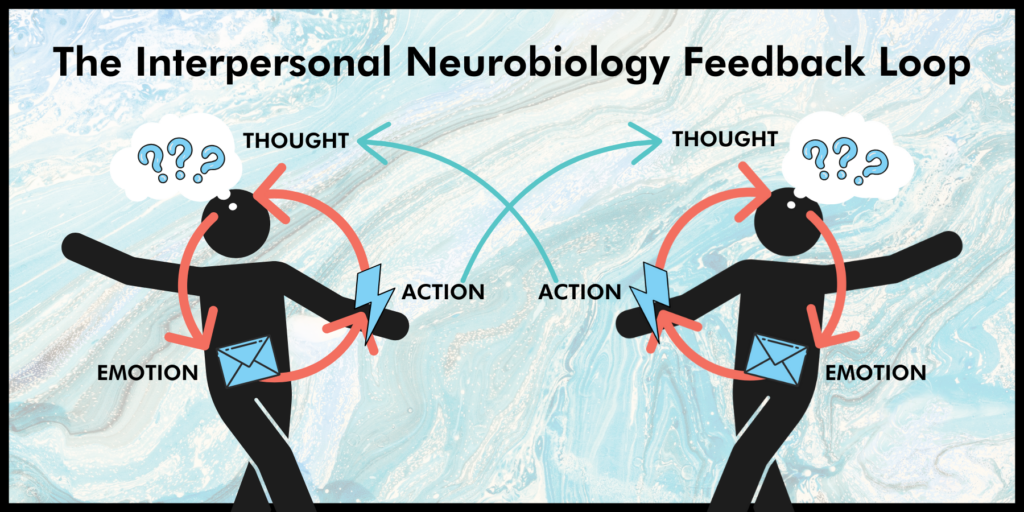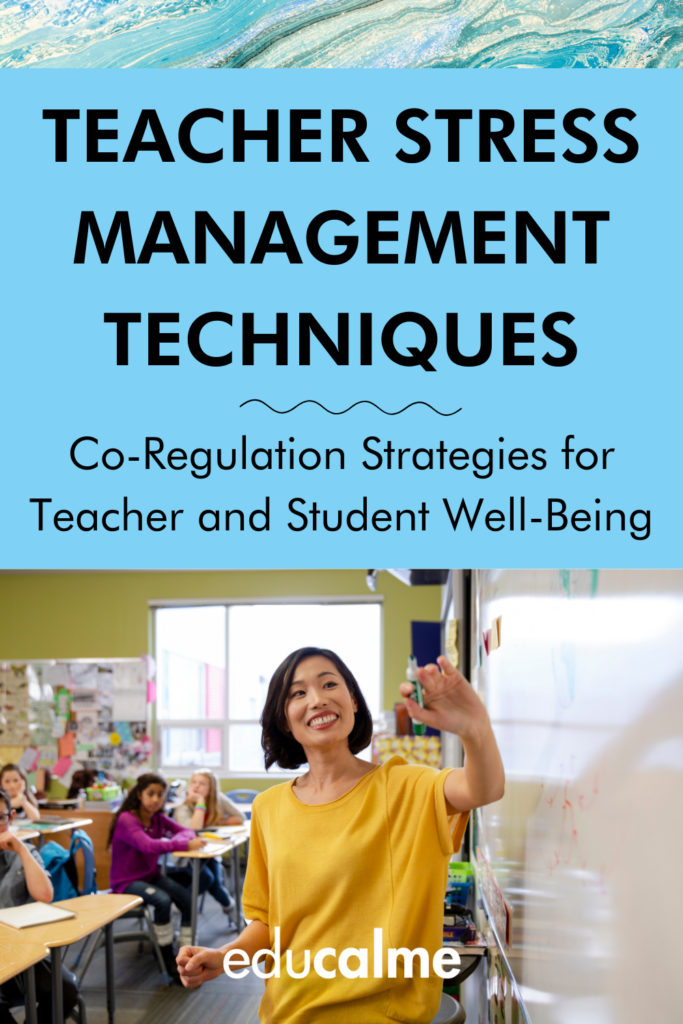Your teaching to-do list is a mile long. Report cards, evaluations, lesson planning—your mind is a whirlwind of responsibilities. A challenging student situation adds complexity. Plus, balancing professional and personal duties leaves you arriving at school fatigued, stressed, and possibly on the brink of teacher burnout.
Have you ever noticed that in these moments, the challenges presented by your students’ behaviours tend to intensify? It’s not a coincidence; it’s the interconnected nature of emotions.
How does stress affect the body? Emotions serve as internal messengers, facilitating communication between different parts of the body. When thoughts of an overflowing plate trigger stress, your body responds with tension, disrupted digestion, or a release of adrenaline and cortisol hormones. This sets off a feedback loop, with stress messages bouncing between body and mind, trapping you in a cycle of fight, flight, or freeze. The human body is designed to oscillate between stress and relaxation, but sometimes, we find ourselves stuck in prolonged stress cycles. This is completely normal and can happen to anyone, but in the long term, it can affect our mental health and well-being negatively.
Understanding this, we can focus on monitoring our thoughts and recognizing when we’re caught in the stress cycle. Shifting thoughts alone might not always suffice, especially when deeply entrenched in stress. In such cases, breaking the cycle through action becomes essential—consider it an intervention to disrupt the loop. While a midday forest walk might not be practical on a school day, alternative actions will be explored later in this article.
The intricate connection between mind and body is rooted in our neurobiology. Emotion acts not only as internal communication but also as a means of understanding and connecting with others—this is interpersonal neurobiology. When teachers arrive at school harboring stress and overwhelm, students’ brains are wired to pick up on these emotions, initiating a reciprocal stress cycle in their own bodies and manifesting in behaviours like lack of focus, potential conflict, and physical discomfort.
While teachers often interpret these behaviours as challenges, considering the underlying thought-emotion-action cycle can provide a deeper understanding. The students’ dysregulation signifies an ongoing internal dialogue prompting their bodies to enter stress mode and their behaviours to reflect that stressed state. This cyclic exchange between teacher and student may hinder effective teaching and learning.
Emotions are contagious. Our neurobiology is finely tuned to efficiently decipher others’ emotions through their actions. Body language often speaks louder than words, revealing true emotional states even when verbalized as “fine.” Hence, when you’re stressed or anxious, students notice and, in turn, exhibit more challenging behaviours. This cycle isn’t exclusive to students; it can emanate from any encounter in your day.

Now, with 25+ students in the classroom, this cycle is much more complex than the example used above. You aren’t the only one sharing their emotional state with others and it isn’t your fault if your students are dysregulated! But, understanding how emotion is shared in a group empowers us to use it to our advantage and leverage interpersonal neurobiology to create a better learning environment. Next, let’s learn a bit more on how to prevent teacher burnout, how to manage stress and get ready for effective teaching and learning!
Recognizing that each student and teacher shows up to school in a different mood, taking proactive actions that aid emotional regulation for everyone is key. Fostering co-regulation – regulating emotions together – with students becomes crucial. Extending beyond immediate needs, in the long term, co-regulation equips students with emotional self-regulation skills, which also leads to easier classroom management.
Effectively engaging in academics requires a regulated body and mind. Starting a lesson without readiness is a common challenge for teachers facing time constraints and pressures from packed schedules and curriculum demands. However, it’s crucial to emphasize that overlooking the vital step of co-regulation is a false economy. Unregulated emotions diminish information absorption, compromising learning quality and causing potential frustration for both teachers and students. Therefore, prioritizing academic content without addressing emotional and regulatory needs first makes the time spent on academics less impactful.
Prioritizing co-regulation is an essential investment, transforming the classroom into an ideal environment for meaningful learning. Efficient emotional regulation maximizes information absorption, optimizing educators’ time and enhancing the overall teaching and learning experience.
Co-regulation doesn’t have to be complicated! Let’s dive into how to easily integrate co-regulation and establish a daily mental hygiene routine in your classroom.
First, select a specific time in the school day to incorporate co-regulation into your routine. Add it to your schedule, whether at the start of the day, after lunch, or during transitions. Consistency is key; establishing a daily routine helps students anticipate and value this dedicated time for emotional well-being. Begin with once a day, and as the routine becomes established, consider increasing the frequency as needed.
Second, practice co-regulation with simplicity in mind. Choose easy-to-implement, ready-to-use resources, keeping activities brief—ideally under 5 minutes—to seamlessly fit into the school day. Success hinges on routine and repetition. Commit to practicing a selected co-regulation strategy for one week to one month, before moving on to the next, allowing students to solidify the strategy in their regulation toolboxes for lasting benefits. Remember, active teacher participation is essential in co-regulation exercises.
Now, let’s explore three effective co-regulation strategies to integrate into your daily routine with your K-12 students:
Experiment with co-regulation strategies to discover what resonates best with your students. Recognize that not all students may participate in every exercise, and that’s okay. Even if they choose not to join in, they will still benefit from the calming shift of the group’s energy. With time, you’ll notice how your co-regulation tools will also become one of your most effective classroom management strategies!
Educalme is an evidence-based K-12 classroom program for mental health and social-emotional learning. It seamlessly integrates time-efficient tools into daily classroom routines, eliminating the need for preparations or professional development. Educalme not only fosters co-regulation but also enhances classroom management, preserving valuable instruction time. Plus, it’s available in both English and French!
In the words of Annette, a grade 5 teacher, “Words cannot express how grateful I am to have discovered Educalme. So many students have experienced traumas that nobody should ever endure. Then, the pandemic. So, self-regulation is a must, and this has helped our class so much.” Annette’s experience reflects that of many educators who consider Educalme a vital resource.
Educalme empowers teachers to foster classrooms where emotional well-being and academic success mutually reinforce each other. This enhances overall mental health, focus, and resilience for both teachers and students, positioning Educalme as a cornerstone in creating thriving learning environments.
Explore Educalme’s free resource library, available in both English at www.educalme.com/welcome and in French at www.educalme.com/bienvenue. For inquiries, contact us at bonjour@educalme.com. And don’t forget to follow us on Instagram!
As you navigate the inevitable stress cycle in your classroom, the choice unfolds: will you fight against it or work with it? Elevate your teaching experience with Educalme—a trusted solution for improving well-being and learning.
